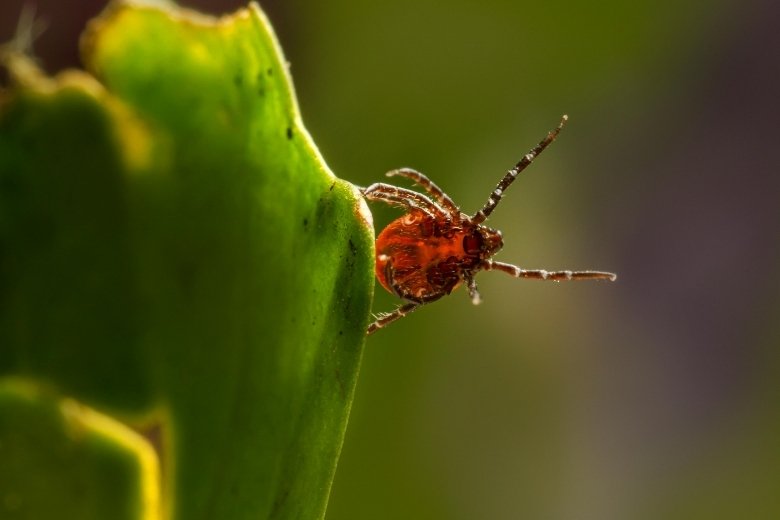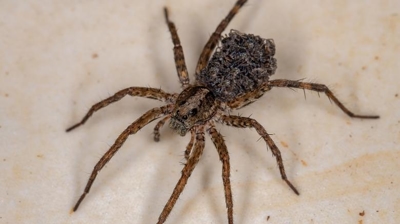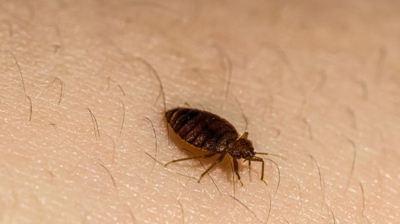
Asian Longhorned Ticks

Asian Longhorned Ticks
Asian longhorned ticks (Haemaphysalis longicornis) are an invasive and harmful species of tick. Their ability to reproduce rapidly without mating, coupled with their aggressive feeding behavior, makes them a particular concern in areas where they have become established. Although no cases have yet been confirmed in the United States, Asian longhorned ticks are known vectors of several pathogens that affect humans in other parts of the world. These include:
- Severe Fever with Thrombocytopenia Syndrome (SFTS): A potentially fatal viral illness endemic to East Asia that causes fever, gastrointestinal symptoms, and bleeding due to low platelet counts.
- Rickettsia spp., Anaplasma spp., and Borrelia spp.: These can cause tick-borne diseases such as anaplasmosis and spotted fever rickettsiosis, although transmission by this tick in the U.S. remains under investigation.
- Allergic reactions and skin irritation: As with other ticks, bites can cause discomfort, allergic responses, and skin lesions.
Due to their silent and often unnoticed feeding behavior, Asian longhorned ticks can remain attached and go undetected for extended periods, increasing the risk of pathogen transmission. In areas where the tick is newly introduced, such as parts of the United States, there is concern about the potential for them to acquire and transmit native pathogens to livestock.
Asian Longhorned Tick Control
Hiring our professional pest control for Asian longhorned ticks (ALT), Haemaphysalis longicornis, is strongly recommended due to the unique risks and challenges associated with these invasive ticks:
- Highly Reproductive and Rapid Spread: Asian longhorned ticks are parthenogenetic, meaning females can reproduce without mating. A single female can establish an infestation, producing hundreds to thousands of offspring. Their populations can grow exponentially, making early intervention crucial. Our professionals have the tools and knowledge to contain and reduce populations before they explode.
- Disease Vector Potential: While research is ongoing, ALTs are known to transmit pathogens to animals, including livestock, pets, and potentially humans. Known pathogens include Rickettsia species, Theileria orientalis (affecting cattle), and other bacterial and viral agents. Our professionals use methods that target ticks effectively while minimizing exposure to pathogens.
- Difficulty of DIY Control: These ticks can infest lawns, gardens, shrubs, and even home perimeters, making complete eradication challenging. Over-the-counter sprays are often ineffective because ticks have life stages in protected environments like leaf litter, tall grass, and shrubs. Our professional pest control ensures systematic treatment of tick habitats using proven products and techniques.
- Safety Considerations: Asian longhorned ticks can attach to humans and pets, causing irritation, allergic reactions, and potential disease transmission. Our professionals know how to apply acaricides safely, minimizing chemical exposure to your family, pets, and the environment.
- Integrated Pest Management (IPM) Approach: Our experts use an integrated approach, including habitat modification (removing tall grasses, brush, and leaf litter), chemical treatments, and ongoing monitoring. This approach is more sustainable and effective than DIY methods alone, reducing the likelihood of re-infestation.
- Early Detection and Ongoing Monitoring: Our professionals can identify tick hotspots that homeowners may overlook. We provide ongoing protective inspections and treatments, which are essential because tick eggs can survive for months before hatching.
Asian longhorned ticks are an aggressive, rapidly reproducing invasive species that pose health risks to humans and animals. Our professional pest control offers targeted, safe, and effective management, reducing the risk of infestation and disease transmission while providing long-term peace of mind.
What Do Asian Longhorned Ticks Look Like?
Asian longhorned ticks (Haemaphysalis longicornis) have distinctive features that set them apart from other tick species. Here is a description of their appearance:
- Size: Asian longhorned ticks vary in size depending on their life stage. Adult females are generally larger, measuring around 3 to 4 millimeters in length, while adult males are slightly smaller, typically measuring about 2.5 to 3 millimeters. Larvae are the smallest and are barely visible to the naked eye, measuring less than 1 millimeter. Nymphs are smaller, usually ranging from 1 to 2 millimeters in length.
- Color: These ticks are typically reddish-brown to dark-brown in color. Their bodies have a flattened, oval shape.
- Mouthparts: One of the most distinctive features of Asian longhorned ticks is their long mouthparts, or capitulum. This structure extends forward from the front of the body and is often referred to as "longhorned" due to its length relative to the tick's body.
- Pale Spots: Along the sides of their bodies, Asian longhorned ticks have a row of pale-colored spots or splotches. These spots are a key distinguishing characteristic and can help differentiate them from other tick species.
While Asian longhorned ticks have these unique features, they can still be challenging to distinguish from other ticks, especially in their immature stages. Therefore, if you encounter a tick that you suspect may be an Asian longhorned tick, it's advisable to consult with a local health or agricultural authority for proper identification and guidance on handling the tick safely.
Where Are Asian Longhorned Ticks Found?
Asian longhorned ticks (Haemaphysalis longicornis) have a wide range of habitats and host animals. They are originally native to East and Central Asia but have been found in several other regions due to their invasive nature. Here are some places where you might find Asian longhorned ticks:
- Grasslands: These ticks are often found in grassy areas, including pastures, meadows, and fields. They are particularly prevalent in areas where livestock graze, as they readily infest cattle, sheep, and horses.
- Woodlands: Asian longhorned ticks can also be found in wooded areas, especially in the transitional zones between grassland and forest. They may attach to wildlife in these environments.
- Urban Areas: In some cases, Asian longhorned ticks have been found in urban and suburban settings. They can hide in tall grasses, shrubs, and other vegetation even in residential areas.
- Wildlife: These ticks infest a wide range of wildlife species, including deer, rodents, birds, and other small mammals. Therefore, you might encounter them in areas where these host animals are common.
- Pets: Asian longhorned ticks can attach to domestic animals, such as dogs and cats. If you live in an area where these ticks are present, it's important to regularly check your pets for ticks after outdoor activities.
- Humans: While Asian longhorned ticks primarily infest animals, they can also bite and attach to humans. If you are in an area where these ticks are known to be present, taking precautions to prevent tick bites is advisable.
- Livestock: Agricultural areas with livestock, such as farms and ranches, are at higher risk of Asian longhorned tick infestations. These ticks can pose significant health risks to livestock through disease transmission.
The distribution of Asian longhorned ticks may vary by region and may continue to expand as they establish themselves in new areas. Local health and agricultural authorities often conduct surveillance and monitoring efforts to track the presence and spread of these ticks. If you suspect you have encountered Asian longhorned ticks in your area or on your property, it's advisable to report the finding to local authorities for further investigation and management.
What Do Asian Longhorned Ticks Eat?
Asian longhorned ticks (Haemaphysalis longicornis) are blood-feeding ectoparasites, and their diet consists exclusively of blood. These ticks feed on a wide range of host animals, including both domestic and wild species. Here's a detailed look at what Asian longhorned ticks eat:
- Livestock: Asian longhorned ticks commonly infest livestock such as cattle, sheep, horses, and goats. They attach themselves to the skin of these animals to feed on their blood. In regions where these ticks are present, they can pose a significant threat to the health of livestock through blood loss and the potential transmission of diseases.
- Wildlife: These ticks are opportunistic and will also infest various wildlife species. This can include deer, rodents, birds, and other mammals. They can attach to and feed on these animals when encountered.
- Pets: Asian longhorned ticks can infest domestic pets like dogs and cats. Pet owners should be vigilant about checking their animals for ticks after outdoor activities, especially in areas where these ticks are known to be present.
- Humans: While Asian longhorned ticks primarily feed on animals, they can also bite and attach to humans. Although they are not commonly associated with transmitting diseases to humans, there have been instances of disease transmission in some regions, particularly related to severe fever with thrombocytopenia syndrome (SFTS) virus.
- Other Hosts: These ticks are opportunistic and can attach to a wide range of animals. They may also infest birds, reptiles, and other small mammals they encounter.
Asian longhorned ticks can be vectors for various diseases, including theileriosis, anaplasmosis, and SFTS virus. When they feed on an infected host, they can transmit these pathogens to other animals or humans during subsequent blood meals. Due to their ability to infest numerous host species and their potential for disease transmission, Asian longhorned ticks are of concern to both agriculture and public health authorities in areas where they are established. Preventative measures, such as tick checks and appropriate tick repellents, are crucial for minimizing the risk of disease transmission.
Asian Longhorned Tick Life Cycle
The life cycle of Asian longhorned ticks (Haemaphysalis longicornis) consists of four stages: egg, larva, nymph, and adult. This tick species has a unique reproductive strategy called parthenogenesis, where females can reproduce without mating. Here's a description of their life cycle:
- Egg Stage: The life cycle begins when a female Asian longhorned tick lays eggs. A single female can lay thousands of eggs at once. The eggs are typically laid in sheltered locations, such as in tall grass or leaf litter, where they are protected from environmental factors.
- Larval Stage: After a period of incubation, the eggs hatch into larval ticks. Larvae are the first feeding stage and have only six legs. They seek out a host animal, such as a small mammal or bird, for a blood meal. Once engorged with blood, larvae detach from the host and molt into the next stage.
- Nymphal Stage: Nymphs have eight legs and are larger than larvae. Like larvae, nymphs also feed on a host for a blood meal. After feeding, nymphs detach from the host and molt into the adult stage.
- Adult Stage: Adult female Asian longhorned ticks are typically larger than males. Both males and females feed on host animals for blood meals. Adult females can reproduce through parthenogenesis, meaning they do not require mating to lay eggs. After feeding, adult females lay eggs, continuing the life cycle.
Asian longhorned ticks can be highly prolific due to their ability to reproduce without mating, which can result in large populations. Additionally, they can infest a wide range of host animals, including livestock, wildlife, and occasionally humans. This makes them a concern for both agriculture and public health, as they can transmit diseases to both animals and humans during the feeding process.

Hear From Our Happy Customers
-
"Great Communication"
Tech was on time, communication was great, and he accommodated my needs.
- Alonzo W. -
"Professional & Considerate"
I’m pleased with Miche services. Jarvis came today. Professional and considerate. Thank you!
- Judy B. -
"Exceeds Expectations"
I can’t say enough positive things about this company... The tech that came out, Jarvis went above and beyond my expectations. Thank you guys, I will continue using your services.
- Jake M. -
"Fantastic & Patient"
Jarvis was fantastic and patient. He answered my questions with an in-depth explanation and addressed all of my areas of concern. Would love for him to be my assigned tech going forward. Well done!
- Yonnette M. -
"Wonderful Service"
Wonderful service. Jarvis is great. Took care of everything I needed. Thank you!
- Henry P. -
"Very Knowledgeable"
The tech that arrived was courteous, professional, and very knowledgeable. He was Great.
- Uerial I.



